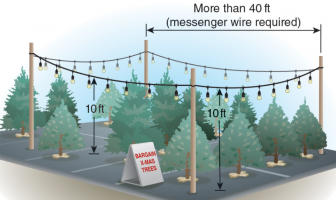jar546
CBO
Festoon lighting, often used during the holiday season and in temporary displays, is subject to specific electrical code regulations to ensure safety and compliance. Here's a breakdown of the key rules:
- Conductor Size: Overhead conductors for festoon lighting must not be smaller than 12 AWG (American Wire Gauge) unless they are supported by messenger wires. This ensures that the conductors can safely carry the electrical load.
- Support for Longer Spans: In spans exceeding 12 meters (40 feet), the conductors must be supported by messenger wires. These messenger wires are further supported by strain insulators to maintain stability.
- Prohibited Attachments: It is strictly prohibited to attach festoon lighting conductors or messenger wires to any fire escape, downspout, or plumbing equipment. Such attachments are unsafe and could potentially provide a path to ground, posing electrical hazards.
- Definition of Festoon Lighting: Article 100 of the electrical code defines festoon lighting as "a string of outdoor lights that is suspended between two points." This definition clarifies the scope of regulations related to festoon lighting.
- Maximum Distance Between Supports: The maximum distance between conductor supports is limited to 40 feet, unless a messenger wire is installed to support the current-carrying conductors. This requirement helps maintain the stability and safety of the festoon lighting installation.
- Prohibition on Certain Attachments: Festoon lighting should never be attached to fire escapes, plumbing equipment, or metal drain spouts. These attachments are not considered secure or safe means of support and are against electrical code regulations.

